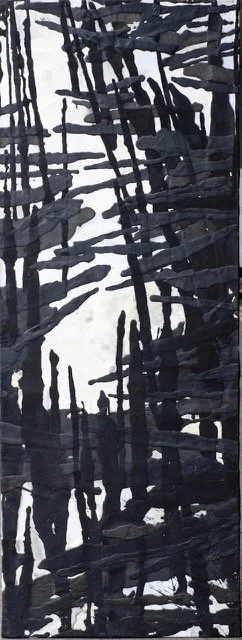
CRISTINA FESSLER
SCHICHTUNGEN
November 14, 2025 - January 24, 2026
Opening November 13, 2025
Although Cristina Fessler’s (1944–2012) work has rarely been exhibited since her death, she is widely regarded as one of the most influential Swiss artists of her generation. As early as the 1980s — a decade defined by turbo-capitalism, nuclear armament, the first ecological crises and the advent of digital technologies — she anticipated the extremes of our time, addressing the longing for interconnectedness and belonging. The exhibition focuses on her “Schichtungen”, works from the 1980s and early 1990s which capture these expansive forces and explore mass, movement and identity as well as empowerment. Fessler's works seem more relevant today than ever before.
The starting point for these works was often her own body. Fessler sat, lay, or stood on canvases spread out on the floor while painting. She then covered the resulting imprints layer by layer with flows of viscous bitumen, sand, graphite dust, and other organic materials. This created visual worlds reminiscent of volcanic landscapes. As Fessler herself said: “I am part of the painting, I am part of the earth.”
In the 1970s, Fessler continued to critically examine traditional images of women. Towards the end of the decade, she turned away from figurative art and found a form of expression in gestural, large-format painting that reflected her need for spontaneity and physical presence. The movement on the picture plane became an act of self-location for her—the resulting layers marked by contradictions: standstill and lived time, precision and indeterminacy, chaos and harmony.
In a next step, Fessler cut up her canvases and installed individual fragments of images on the wall. As Ewa Rotzler from the Atelierhäuser am Waldrand aptly put it in 2020: "...the experience of loss of wholeness is inscribed: they are memories of the chaos from which the world, from which we ourselves emerge. To the flow of energies, thoughts, desires, hopes—completely without intention or purpose. Once cut up, the pieces of the image take on a life of their own, but always refer to a larger whole that can no longer be reconstructed."
Fessler's “Schichtungen” reflect the full intensity of the 1980s. In this constant oscillation between elation and abyss, many artists sought emotional visual languages beyond the dominant rationality. Fessler found this in the direct connection with organic material, bitumen—a building material derived from petroleum—as well as sand and graphite dust. Fessler sometimes refers in her titles to the Indonesian volcano Krakatoa, which erupted with unimaginable vehemence in 1883 and had worldwide consequences. However, the artist is not concerned with the destructive force of the volcanic eruption, but rather with the geological processes and the eruptive, transformative power that discharges arbitrarily, devoid of any rationality. This is where the explosiveness of Cristina Fessler's work lies in particular. This “yes to universal vigor” also reveals the artist’s political credo.
Cristina Fessler was born in northern Italy in 1944. Her parents moved to Switzerland in 1946. After studying art history at the University of Zurich for several semesters, she started working as an artist in 1972. She held her first exhibitions in 1973 and participated in the Venice Biennale in 1976. In 1983, the Kunsthaus Zurich dedicated its first museum exhibition to her, followed by another in 1987. In 1993, the Helmhaus held a solo exhibition of her work. From 1998 to 1999, she was a visiting professor at the Kunsthochschule Kassel. In 2004, she undertook a study visit to Budapest, funded by the Zug-based cultural foundation Landis & Gyr. Cristina Fessler passed away on 5 June 2012 in Zollikon near Zurich.
Schichtungen, 1986
Bitumen, tar, sand, tape and latex on canvas
183 x 154 cm / 72 x 60-5/12 inches
Die Braut des Krakatan, 1984
Bitumen, tar on canvas
200 x 131 cm / 78-3/4 x 51-1/2 inches
Konstellation, 1986
Bitumen and tar on canvas
210 x 156 cm / 82-5/12 x 61-1/2 inches
290 x 61 cm / 114-1/2 x 24 inches
2 parts
Schichtungen, 1986
Bitumen, tar and latex on canvas
277 x 82 cm / 109 x 32-1/4 inches
Schichtungen, 1986
Bitumen and tar on canvas
200 x 75 cm / 78-3/4 x 29-1/2 inches
Schichtungen 1986
itumen and tar on canvas
201 x 75 cm / 79-1/12 x 29-1/2 inches





